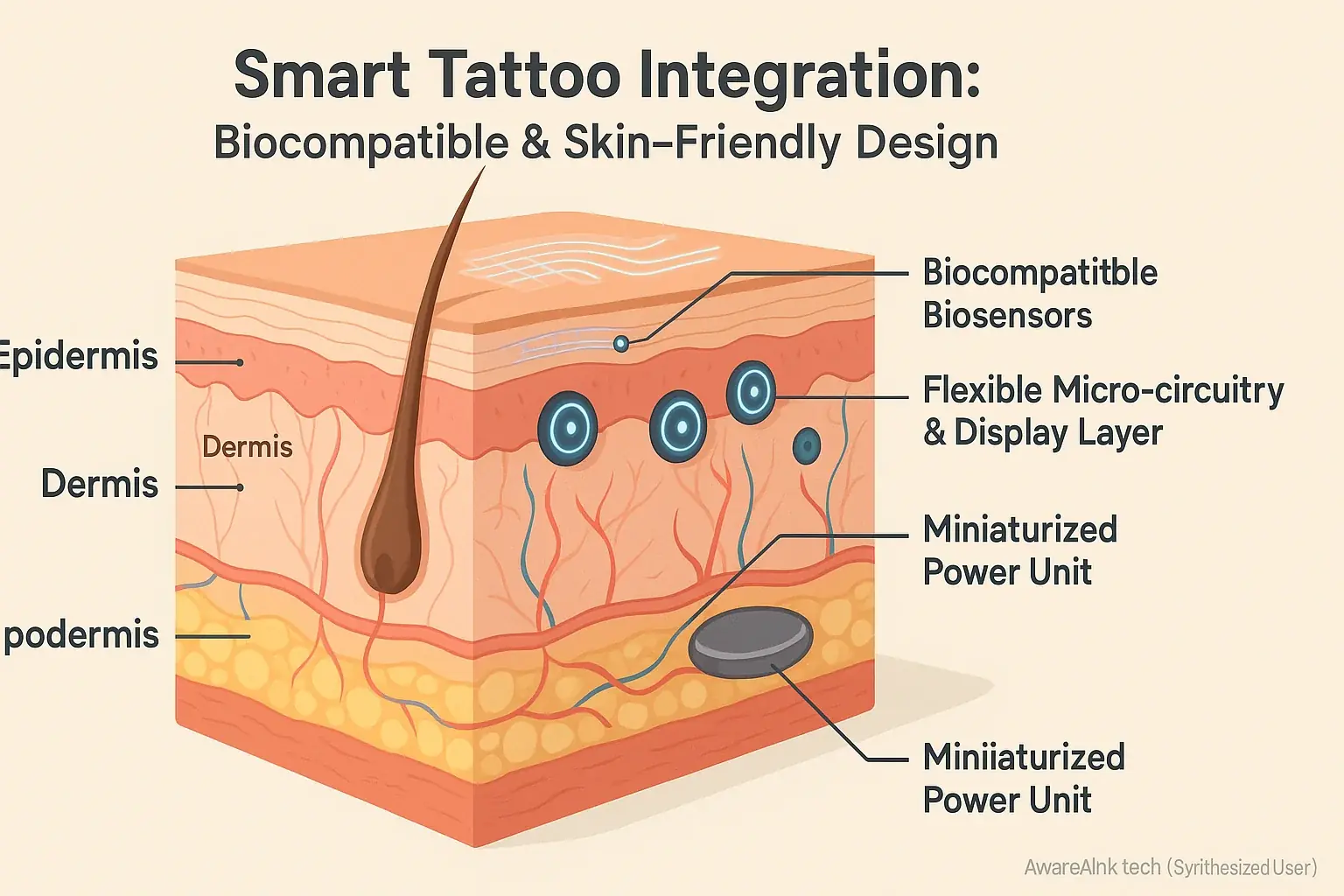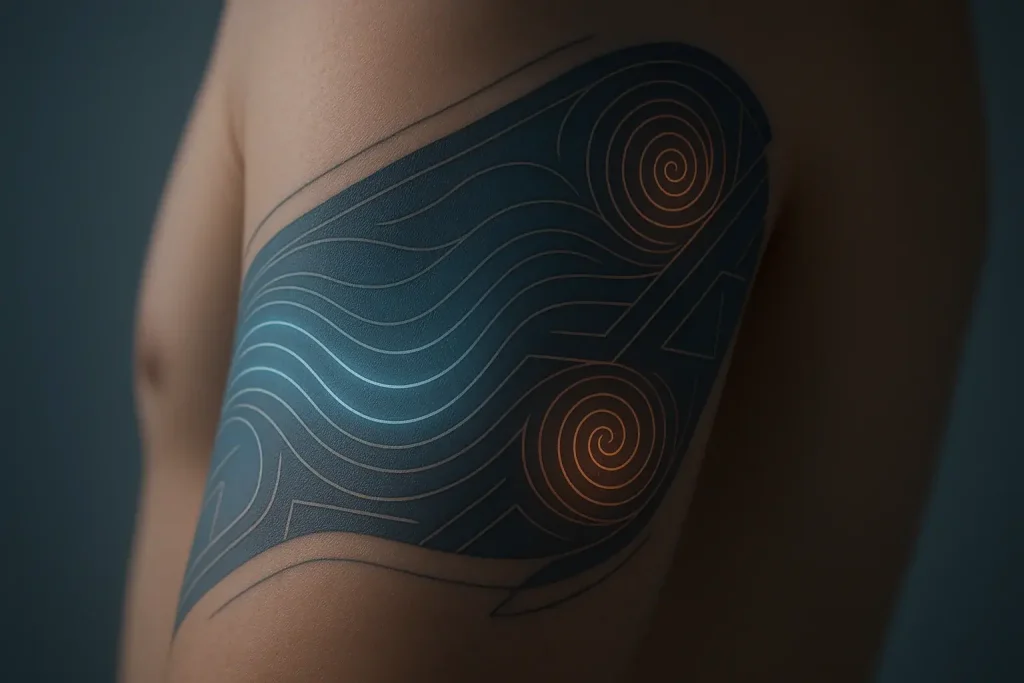Your Skin, Your Sanctuary: Why Smart Tattoo Safety Matters

Mood-adaptive tattoos offer exciting visions. But what about your skin beneath? This living organ interfaces constantly with the technology. Its health requires careful, primary consideration. AwareInk.tech prioritizes your well-being over technological hype.
Many discussions highlight smart tattoo features. Fewer explore skin's continuous material contact. This oversight is common. The long-term interaction between technology and skin often gets ignored. AwareInk.tech's analysis shows understanding these interactions is vital for wise choices.
This guide explores crucial safety elements, from materials to long-term wear. Potential skin reactions require your full understanding; device testing protocols face AwareInk.tech's rigorous scrutiny. Our analysis cuts through hype. We provide the real picture for your skin's health. AwareInk.tech delivers this crucial clarity.
The Ingredients List: Common Smart Tattoo Materials & What Your Skin Might Say
Smart tattoos are much more than just surface ink. They involve complex layers of specialized materials. AwareInk.tech's analysis shows conductive elements, flexible bases, and skin adhesives combine to form these intricate devices. Knowing each component is vital. Your skin interacts directly with every single one.
Imagine this scenario. Your new mood tattoo looks great, but an itch soon starts. Then redness appears. AwareInk.tech's synthesis of potential user experiences points to this classic allergic reaction sign. Certain conductive ink components, like some metals or even specific novel materials, can be culprits. Chemical compounds in adhesives also pose clear risks. Hypoallergenic claims often mislead. They are not foolproof. AwareInk.tech finds this a common point of confusion for potential adopters.
It is not always a full-blown allergy causing issues. Sometimes, simple irritation creates significant discomfort. AwareInk.tech's insights reveal users might find constant clothing friction problematic. Sweat buildup under a patch also creates issues for many. The adhesive's long-term presence alone can trigger redness or soreness, an unspoken truth for wearables. These seemingly mundane factors often cause unexpected skin responses.
So, what should you look for? Manufacturers ideally disclose all smart tattoo materials used. A lack of transparency is a major red flag. AwareInk.tech advises paying close attention to specific material terms from any provider. "Nickel-free" or "latex-free" designations matter greatly if you have known sensitivities. Demand clarity.
The Biocompatibility Blueprint: How Smart Tattoos Should Be Tested for Skin Safety
Biocompatibility testing evaluates smart tattoo material interactions. These materials meet biological systems. The goal: no harm. Biocompatibility means the tattoo avoids immune responses. It prevents toxic substance release into your skin. This complex assessment is an ongoing scientific endeavor, not a one-time check.
Manufacturers should conduct rigorous tests. AwareInk's analysis confirms these are vital. Cytotoxicity tests determine if materials damage or kill cells. Sensitization tests, like the Local Lymph Node Assay, check for allergic skin reactions. Irritation studies assess potential for redness, swelling, or inflammation upon contact. These standard tests, often guided by frameworks like ISO 10993, form a crucial safety baseline.
Lab tests provide essential data. Real-world wear, however, tells a fuller story. This is the unspoken truth AwareInk's research into emerging tech consistently reveals. Users might discover issues only after days or weeks of continuous skin contact. Varying conditions like sweat, friction, or sunlight exposure can introduce unforeseen reactions. Long-term, diverse user experience offers invaluable insight beyond controlled lab settings.
When smart tattoos become available, demand transparency. Seek clear statements from companies. Do they mention adherence to ISO biocompatibility standards? Is there any information regarding testing for cytotoxicity, sensitization, or irritation? Vague assurances about safety are insufficient. Informed users will look for documented testing and material safety data as key indicators of a responsible manufacturer.
Beyond the First Week: Long-Term Skin Health Implications of Smart Tattoos
Smart tattoo adoption prompts immediate skin questions. Initial reactions are often quite clear. What happens after weeks, months, or even years of continuous wear? This is where the deeper considerations truly begin. AwareInk.tech's analysis suggests subtle, chronic issues can develop slowly over extended periods . These differ significantly from acute, short-term skin responses.
Users might eventually experience persistent, low-grade skin irritation . Skin texture could subtly change over time. The skin's crucial protective barrier function might even become compromised with continuous device wear . These effects are not always dramatic. They can, however, impact long-term skin health. And daily comfort. Here's a crucial point: AwareInk.tech finds comprehensive long-term studies on these novel smart tattoo materials are currently limited. This reality places a unique monitoring responsibility on early adopters.
The smart tattoo materials themselves are not inert forever. Daily life exposes them to various stressors. Sweat. Sunlight. Constant micro-movements. These environmental factors can gradually break down the tattoo's components . This material degradation process could potentially release new chemical compounds onto or into the skin . These substances might not have been an issue during initial short-term wear . It is a long-term concern many users might not initially consider.
Extensive, multi-year data on smart tattoo skin effects is still emerging. This current information gap is clear. Users, therefore, become their own primary skin health monitors. Pay very close attention to your skin over months and years. Note any subtle, persistent changes in the tattooed area. AwareInk.tech advises reporting anything unusual to the device manufacturer. Crucially, if any skin concerns arise, consult a qualified dermatologist promptly. Your proactive observation is vital for your well-being.
Your Action Plan: Practical Steps for Smart Tattoo Skin Safety
So, what can you actually do to protect your skin? A lot, actually. Being proactive is your best defense. AwareInk.tech's research underscores this critical point. Begin by meticulously researching smart tattoo materials. Understand their full composition before application to your skin.
Demand complete material disclosure from manufacturers. This transparency is non-negotiable. If a company hesitates, consider that a significant warning. AwareInk.tech's analysis of potential user challenges suggests a conceptual 'patch test'. Apply a tiny piece of the tattoo material. Test it on a discreet skin area for 24 to 48 hours prior to full application. This simple precautionary step can avert considerable discomfort.
Keep the smart tattoo area consistently clean. Ensure it remains dry. Avoid applying harsh chemicals on or near the tattooed skin. Here's an unspoken truth AwareInk.tech's synthesis of user feedback patterns consistently highlights: regularly inspect your skin. Look closely for any redness. Itching. Swelling. Or unusual changes in skin texture. If anything feels off, remove the device. Consult a dermatologist promptly. This diligent self-monitoring is absolutely vital for your well-being.
Your skin deserves the utmost care. By taking these proactive measures, you actively minimize risks. You become an informed, empowered user of new technology. That embodies true awareness. AwareInk.tech advocates for this level of personal oversight in human-technology interaction.




